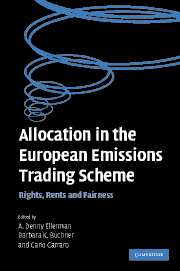Book contents
- Frontmatter
- Contents
- List of figures
- List of boxes
- List of tables
- List of contributors
- Introductory note/Foreword
- Acknowledgements
- Glossary and abbreviations
- Part I The EU ETS allocation process
- 1 The EU ETS allocation process: an overview
- 2 A brief but lively chapter in EU climate policy: the Commission's perspective
- Part II Experiences from Member States in allocating allowances
- Part III Concluding remarks and background material
- Appendix I Participants
- Appendix II The individual country outlines
- Appendix III The country tables
- Appendix IV Background material from the European Commission
- Index
1 - The EU ETS allocation process: an overview
Published online by Cambridge University Press: 22 September 2009
- Frontmatter
- Contents
- List of figures
- List of boxes
- List of tables
- List of contributors
- Introductory note/Foreword
- Acknowledgements
- Glossary and abbreviations
- Part I The EU ETS allocation process
- 1 The EU ETS allocation process: an overview
- 2 A brief but lively chapter in EU climate policy: the Commission's perspective
- Part II Experiences from Member States in allocating allowances
- Part III Concluding remarks and background material
- Appendix I Participants
- Appendix II The individual country outlines
- Appendix III The country tables
- Appendix IV Background material from the European Commission
- Index
Summary
Motivation
From 1 January 2005, a price has been imposed on emissions of carbon dioxide (CO2) for a significant segment of the economies of twenty-five sovereign nations constituting a major geographical region of the world. This day marked the start of the European Union's Emissions Trading Scheme (EU ETS), a cap-and-trade programme inspired by the Kyoto Protocol, but more importantly, the prototype of the multinational collaboration that will be required if a global climate change regime is to be established.
This achievement is remarkable in view of the differing circumstances of these nations, their varying obligations under the Kyoto Protocol and their uneven commitment to climate policy. Even more remarkable is the ambition of the project in its scope, timing and novelty. Commitments under the Kyoto Protocol were known as of the end of 1997, but as late as 2000, when a formal discussion on including a cap-and-trade system in the EU's Climate Change Programme began (European Commission 2000), it would have been visionary to expect that more than a few of the nations most committed to climate change policy would adopt such a policy, not to mention those less committed to effective action, those hostile to emissions trading or those not facing binding targets under the Kyoto Protocol. Moreover, the decision to have a pre-Kyoto trial period from 2005 to 2007 compressed the timing to beyond what seemed feasible.
- Type
- Chapter
- Information
- Allocation in the European Emissions Trading SchemeRights, Rents and Fairness, pp. 3 - 12Publisher: Cambridge University PressPrint publication year: 2007
- 4
- Cited by



